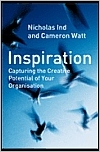Pre-publication
endorsements'Essential reading for anybody who wishes to better understand the vital and
complex role that creativity plays in successful business.' - Sir Terence Conran
This book is about how organizations can best develop and manage a creative
environment and creative potential. The authors argue that organizations consist of people
who have creative potential to think in new ways and yet are often denied the opportunity
to do so. The goal of the organization should be to create a structure and culture that
encourages the conditions in which creativity can flourish. This will generate significant
competitive advantages for the organization by offering clear differentiation, by
communicating postive brand attributes to stakeholders that will strengthen the
organization's intangible assets and by providing a creative and challenging environment
that will attract and retain the best staff.
Table of Contents
Inspiration and Creativity
Creative Organisations at Work
Designing Creativity
Managing for Creativity
Aardman and Funcom: Animated Creativity
Balancing Act: Designing and Managing Creative Teams
Cultural Creativity
Customers, Creativity and Risk
Quicksilver: Cool Creativity
Branding and Creativity
Driving Creativity: Ford's Premium Automotive Group and VW-Audi
Author Biographies
NICHOLAS IND is a Brand
Consultant and Writer. He has worked for his own branding consultancy, as the director of
a design group and as an account director for an advertsing agency. His specialist area is
helping organizations to build internal commitment to brands. He is the author of six
books including, The Corporate Image, Terence Conran - The Authorised Biography, The
Corporate Brand and Living the Brand. He lectures on branding and communication at Erasmus
University, Rotterdam, Stockholm University, BI University, Oslo and Kingston University,
where he is Industrial Fellow.
CAMERON WATT has worked in the creative industry for over 15 years initially specializing
in commercial design and branding. He has worked at a strategic level on creative brand
development for organizations such as Tesco, Microsoft, and Rolls Royce and acted as a
creativity, change and innovation consultant for a number or organizations including IBM,
Sainsbury plc, and National Air Traffic Services. He lectures on creativity at a number of
business schools including Warwick Business School and Kingston Business School.
172 pages


